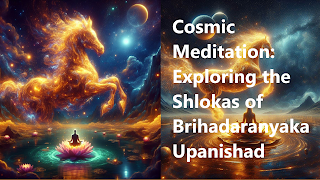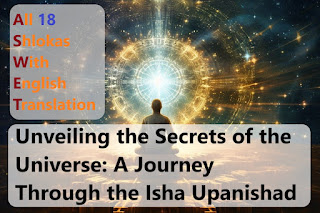Welcome back to our blog. Our focus today will be on the shlokas of the first Brahmana within the first chapter of the Brihadaranyaka Upanishad.
You can read or recite the shlokas.
Shloka 1.1.1
ॐ उषा वा अश्वस्य मेध्यस्य शिरः॥
सूर्यश्चक्षुर्वातः प्राणो व्यात्तमग्निर्वैश्वानरः संवत्सर आत्माऽश्वस्य मेध्यस्य॥
द्यौः पृष्ठमन्तरिक्षमुदरं पृथिवी पाजस्यं दिशः पार्श्वे अवान्तरदिशः पर्शव
ऋतवोऽङ्गानि मासाश्चार्धमासाश्च पर्वाण्यहोरात्राणि प्रतिष्ठा नक्षत्राण्यस्थीनि नभो मासानि।
ऊवध्य सिकताः सिन्धवो गुदा यकृच्च क्लोमानश्च पर्वता ओषधयश्च वनस्पतयश्च
लोमान्योद्यन् पूर्वार्धो निम्लोचञ्जघनार्धो तद्विजृम्भते तद्विद्योतते
यद्विधूनुते तत्स्तनयति यन्मेहति तद्वर्षति वागेवास्य वाक्॥ ||१||
"oṃ uṣā vā aśvasya medhyasya śiraḥ॥
sūryaścakṣurvātaḥ prāṇo vyāttamagnirvaiśvānaraḥ saṃvatsara
ātmā'śvasya medhyasya॥ dyauḥ pṛṣṭhamantarikṣamudaraṃ pṛthivī
pājasyaṃ diśaḥ pārśve avāntaradiśaḥ parśava ṛtavo'ṅgāni
māsācchārdhamāsāśca parvāṇyahorātrāṇi pratiṣṭhā nakṣatrāṇyasthīni
nabho māsāni। ūvadhya sikatāḥ sindhavo gudā yakṛcca klomānaśca
parvatā oṣadhayaśca vanaspatayaśca lomānyodyan pūrvārdho
nimlocañjaghanārdho tadvijṛmbhate tadvidyotate yadvidhūnute
tatsstanayati yanmehati tadvarṣati vāgevāsya vāk॥ ||1||"
English Translation:
Om, The head of the sacrificial horse is the dawn, one eye is the Sun, the vital force is the air, the open mouth is the fire named 'Vaisvanara', the trunk is the year, the back is heaven, the belly is the sky, the hoof is the earth, the flanks are the four directions, the ribs are the intermediate directions, the limbs are the seasons, the joints are the months and fortnights, the feet are the days and nights, the bones are the stars, the flesh is the clouds, the half digested food in the stomach is the sand, the arteries and veins are the rivers, the liver and spleen are the mountains, the hairs are the herbs and trees, the forepart is the rising sun, the hind part is the setting sun. It's yawn is lightning, the shaking is the thunder, it's making water is the rain and it's neighing is the speech.
Shloka 1.1.2
अहर्वा अश्वं पुरस्तान्महिमाऽन्वजायत तस्य पूर्वे समुद्रे योनी
रात्रिरेनं पश्चान्महिमान्वजायत तस्यापरे समुद्रे योनिरेतौ वा अश्वं
महिमानावभितः सम्बभूवतुः। हयो भूत्वा देवानवहद्वाजी गन्धर्वानर्वाऽसुरानश्वो
मनुष्यान्त् समुद्र एवास्य बन्धुः समुद्रो योनिः॥ ||२||
"Ahervā aśvaṁ purastānmahimā'nvajāyata tasya pūrve
samudre yonī rātrirenāṁ paścānmahimānvajāyata tasyāpare
samudre yoniretau vā aśvaṁ mahimānāvabhitaḥ sambabhūva-tuḥ।
Hayo bhūtvā devānavahadvājī gandharvānarvā'surānaśvo
manuṣyānt samudra evāsya bandhuḥ samudro yoniḥ॥ ||2||"
English Translation:
The day verily is the golden cup in front called Mahiman which arose in respect of horse. It's source is the eastern sea. The night is the silver cup behind called Mahiman which arose in respect of the horse. It's source is the western sea. These two cups are verily called Mahiman appeared on either side of the horse. As a steed it carried the gods; as a stallion the celestial minstrels; as courser, the demons; and as a horse, men. The sea is it's stable, the sea is it's source.
Before we interpret, I recommend you to read the previous article on introduction of Brihadaranyaka Upanishad. You can read the articles on Isha Upanishad to unveil the Secrets of Self in case you missed it. Links to those articles are given at the bottom.
Let me tell you a small story from Lord Krishna's childhood. Baby Krishna was eating soil while playing. His mother Yashoda scolded him and asked him to open his mouth. Mother Yashoda fainted after seeing inside his mouth. She saw whole universe inside Baby Krishna's mouth.
In the ancient Vedic age, horse sacrifice was considered to be the greatest rite. The presiding deity is Prajapati (Hiranyagarbha) in this sacrifice. The sacrificer should not just do the rite but meditate on the horse, as the horse is the object of sacrifice. In this type of meditation, the meditator super imposes some imaginary objects on the object of meditation. Here, horse is superimposed by different objects and phenomenon from the earth and cosmos, Like stars, sky, rivers, directions, time, sun rise to sun set, day and night etc. Horse is just the gateway to channelize meditator 's thought and imagination to Hiranyagarbha or Prajapati or the Universe.
It's okay even if you replace the horse with yourself. You can think yourself as the cosmic being and whole universe is your body. Imagine yourself as Prajapati and meditate upon that. Lord Krishna's story indirectly teaches us this meditation.
In the second shloka, we read different types of horses are carrier of different purposes. Same way we carry different personality inside us. Sometimes we are pleasant and kind like God. Sometimes we are cruel and egoistic like demon. Sometimes we are laborious and curious like man. Sometimes we live in unreal fairy world like celestial minstrels do.
The most important part of the two shlokas is "The sea is it's stable, the sea is it's source.". Same way Brahman is the source from where the Universe or Hiranyagarbha or Prajapati came. Alike stable is home of Horse, the Universe's home is the Brahman. In this relation, let me quote my last interpretation on introductory mantra. "Brahman is self competent to give birth to the Universe. Brahman is infinite because it is endless and beginningless. It was there before this Universe. It will be there after this Universe. The Universe started from the primordial source of compressed energy as we know from Big bang theory. From then this Universe is expanding and we are seeing in the current shape. The Universe is so huge we don't know where it ends. Because of our limitation we can know till one boundary but the Universe is larger than the observable universe."
If you notice carefully, you will find the meditation started from a horse, then shifted to everything required to flourish a life on this earth, finally reaching the source of everything. From object to objective world and from there to the abstract world of Brahman. That is the goal of any meditation.
When we have divided ourselves in the name of species, ethnicity, complexion, race, class, creed, cast, community, religion, gender, ideology, nation, fan club, political parties, sexual orientations etc., practicing this meditation can develop the thought of oneness and inclusiveness among everyone and everything and even with the Universe and beyond that. It promotes universal brotherhood and sense of the world is one family. It opens our eyes and we understand that all beings are interconnected and part of a larger whole. This understanding fosters a sense of responsibility and compassion towards all living beings and the environment. By recognizing the interconnected nature of life, this shloka promotes a holistic perspective that encourages individuals to consider the impact of their actions on others and the world around them.
Dear readers, be with us in this journey of Universal Vedanta movement.
Do not forget to share this blog and YouTube video with your friends and families. Like the video. Subscribe to our YouTube channel - Universal Vedanta if you have not yet. Press the bell icon, so that as and when any new session or video is released, you will get notified. If you have any question or want to share your thoughts, use the comment section for that. You may want to follow us on WhatsApp channel, Facebook, Instagram , X and Koo. Thank you and have a great day. Will see you soon in the next blog and video.
Follow us on
Readers' List
Isha Upanishad - Shloka - 09




Comments
Post a Comment